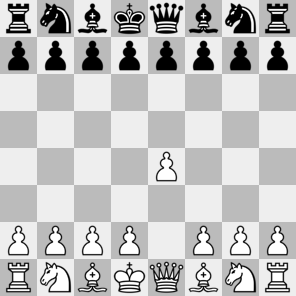‘Wait!’ I hear you exclaim, ‘La Bayadère? Didn’t you talk about that before?’ I did! In fact, it is the same Makarova adaptation of Petipa’s choreography that I’ll be talking about today – but this time it’s the Royal Opera House, with Ovsyanikov conducting and Rojo, Acosta, and Nuñez doing the dancing. Since the choreography is the same, there is also some chess but, of course, a different production means a different chess scene.1 This is what the second scene of the first act looks like this time:
The grand gesture of the guy on the left is caused by him pushing a pawn. Unfortunately – and this was a problem in the previous Bayadère, too – the director seems to focus on the dancers instead of the chessboards. Consequently, I am not entirely sure of the move just made, but I believe it was 1. e4. All other pieces seem to be on their starting positions, but there are some I can’t quite make out. And there is one major exception: the kings and queens have swapped places.
The position shown above is therefore probably this one:2
 which is an unholy abomination against mankind! Or a standard opening position where the players just decided to mirror the board over the border of the d- and e-file.
which is an unholy abomination against mankind! Or a standard opening position where the players just decided to mirror the board over the border of the d- and e-file.
In this position, black plays Nf6 with all the aplomb one would expect from a professional ballerino. But perhaps that’s not wholly justified, because white now has a wide array of pleasant options, like 2. Nf3 with possible transposition to the Chigorin opening, the ambitious 2. d5 which gives the position a more unique character, or — perhaps the most annoying — 2. e4.3
And then disaster strikes! Instead of focusing on his game and finishing it like decent people, the players get distracted by a king they have to greet and a woman one of them has to fall in love with and marry and they abandon the game. What a pity! There was still everything to play for. The position could even have become legal at some point.
Realism: 0/5 The position is illegal. What other score could I give it?
Probable winner: Who know? The position is basically the same as in an actual game after 1. d4 Nc6, which probably gives white some initiative, but it’s not in any way a forced loss for black.
1. [Which in turn means that I can probably keep this blog running for a year just with different productions of La Bayadère.] ↩
2. [In a production by Apronus.] ↩
3. [Although, perhaps, taking your opponent’s queen of the board while going ‘neener, neener, neener’ would be even more annoying.] ↩
